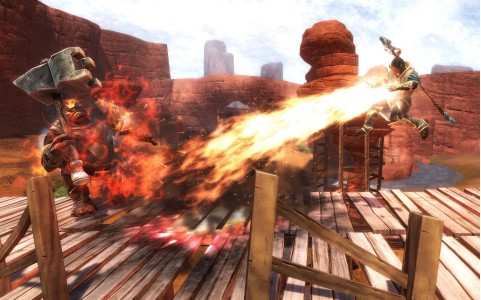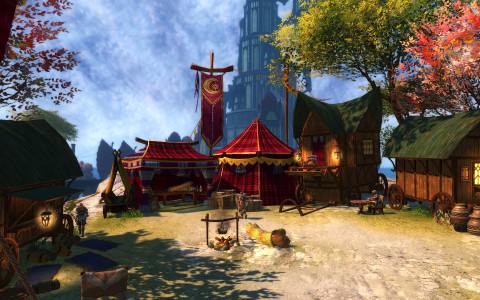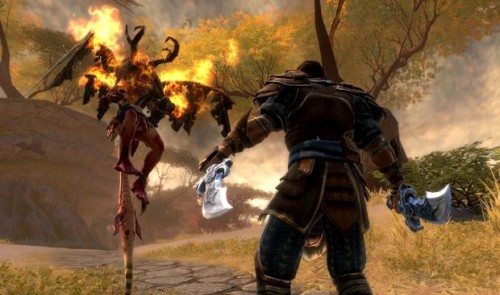It’s not every video game studio that can claim to have a new property with thousands of years of history penned by R.A. Salvatore, creatively helmed by former-Bethesda designer Ken Rolston, and visually created by the acclaimed artist Todd McFarlane. It’s also not every studio that can claim to truly create a deep RPG experience while maintaining an open world full of life and including a great, fluid combat system.
Kingdoms of Amalur: Reckoning has got some big names behind it, and from my short couple of hours with the game, I can safely say that it does also deliver in the design department. EA took a big chance in funding a new franchise among what seems like an endless stream of sequels, spinoffs, and remakes, and so far it seems that 38 Studios and Big Huge Games have more than converted the risk into reward.
At the outset of the game the player is quickly thrust into the world of Amalur via a cutscene which details the how a race of elves has spent the last decade converting from peaceful denizens of the universe, into an angry, mass-murdering mob under the leadership of a new king. The catch is, death doesn’t affect them, and though they’ve been held off for most of the past ten years, humans and friendly elves are losing numbers where the enemy seems to have infinite respawns.
Somewhere in that conflict, you die. Game over.
As your body is dragged to what is apparently a trash chute, you get to customize the race, appearance, and name of your dead character, and then it’s down the chute you go.
Queue you vigorously shaking off a pile of dead bodies and stepping onto the stone floor of an underground cavern. Turns out the trash chute was part of the Well of Souls, a machine that can bring back the dead, but you’re the only experiment that has succeeded thus far.
Now you may have noticed that it’s the beginning of an RPG and I wasn’t asked to choose a class. Rather, I played through an extended tutorial that led me through a siege on the Well of Souls. Throughout this experience, the game showcases stealth combat, magic, shields, and swords. You can sneak behind enemies with daggers, for instant stealth kills, or blast through them with fire and lightning, or simply run into a room, slashing at everything in sight, knowing your armour will protect you from the brunt of enemy attacks. You can map two weapons to your character, and you can easily switch between them mid-combat in order to wreak havoc in different ways, and your character’s magic abilities are mapped to the face buttons. This is no Dragon Age. There’s no pausing and selecting abilities, it’s quick and frantic, built around strategy and a fair bit of button mashing.
Being the cheeky person I am, I opted to go for a mix of all three play possibilities, as many games punish players who take the middle road. So upon exiting the tutorial, out stepped a stealthy elf daggers on his side, fire-staff ready to go, and all dressed in heavy armor, and, believe it or not, this strange hybrid worked exactly as I’d wanted. This was helped by the destinies system, which you are introduced to as you escape the Well of Souls.
The system essentially allows you to create your own class. You can put points into Finesse, Might, or Magic and each will unlock different bonuses. You can then unlock different fate cards which will also skew to one of those playstyles. However, you can mix and match as you please, and the fate-cards available to change depending on your Destiny selection. So if you like playing your way, the game’s completely supportive of that. And if you’re not happy, you can always visit a Fateweaver, who will refund your destinies for a bit of gold.
Now I’ve barely scratched the surface here. Kingdoms of Amalur: Reckoning is an open-world game, and playing it for a couple of hours is no way to do such a game justice. Aside from the main storyline, there are side-quests everywhere. It seems everyone in Amalur has got a problem, and most of the time, they’re fun problems to solve. On top of that, simply setting out and exploring can lead you to treasure troves in the wilds, as well as dungeons full of enemies and loot. The combat was fluid, and as my strangely equipped character flung electricity through the air, infiltrated bandit-ridden caverns, and became quite a smooth, persuasive talker, I felt like Amalur was really a world that I could see myself spending hours upon hours in.
This is complimented by an art-style which is almost a blend between realism and cartoon. Everything in the world buzzes with life, whether it’s fireflies flying up from grass, a plant shriveling as you harvest it, or the light streaming in from over a cliff. As I managed to get my hands on to both the PC and Xbox 360 versions of the game, I can absolutely confirm that the game looks markedly better on PC. Where the Xbox relies of the atmosphere created by the art-style to cover up some of its hitches, I couldn’t help but notice murky textures in quite a few of the locations. Such issues were non-existent on PC, but what was impressive were the fluid character animations which both versions maintained. If the game were to be judged on animation alone, it could pass off as God of War or Darksiders.
There was another cross-platform issue, though this time the problem was with the PC. The controls just feel so much better on Xbox, and though PC gamers can adjust keys as usual, there’s still something left to be desired from the mouse and keyboard.
So the verdict on which platform was best? Much like my hybrid character, I’d go for the mix: a high-end PC with an Xbox 360 controller plugged in was definitely the optimal experience.
Whichever way you play it, Kingdoms of Amalur: Reckoning is shaping up to be a massive RPG, complemented by a great art style and exciting combat mechanics. We’ll all have to wait for February 9th, 2012 to get our hands on the game, but I, for one, can’t wait to see more.






